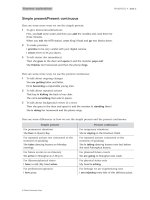ENGLISH PAGE present continuous
Bạn đang xem bản rút gọn của tài liệu. Xem và tải ngay bản đầy đủ của tài liệu tại đây (149.53 KB, 3 trang )
25/2/2016
ENGLISH PAGE Present Continuous
englishpage.com
Home > Verb Tense Tutorial > Present Continuous
Present Continuous
f
t
g+
p
FORM
[am/is/are + present participle]
Examples:
You are watching TV.
Are you watching TV?
You are not watching TV.
Complete List of Present Continuous Forms
USE 1 Now
Use the Present Continuous with Normal Verbs to express the idea that something is
happening now, at this very moment. It can also be used to show that something is not
happening now.
Examples:
You are learning English now.
You are not swimming now.
Are you sleeping?
I am sitting.
I am not standing.
Is he sitting or standing?
They are reading their books.
They are not watching television.
What are you doing?
Why aren't you doing your homework?
/>
1/4
25/2/2016
ENGLISH PAGE Present Continuous
USE 2 Longer Actions in Progress Now
In English, "now" can mean: this second, today, this month, this year, this century, and so
on. Sometimes, we use the Present Continuous to say that we are in the process of doing
a longer action which is in progress; however, we might not be doing it at this exact
second.
Examples: (All of these sentences can be said while eating dinner in a restaurant.)
I am studying to become a doctor.
I am not studying to become a dentist.
I am reading the book Tom Sawyer.
I am not reading any books right now.
Are you working on any special projects at work?
Aren't you teaching at the university now?
USE 3 Near Future
Sometimes, speakers use the Present Continuous to indicate that something will or will not
happen in the near future.
Examples:
I am meeting some friends after work.
I am not going to the party tonight.
Is he visiting his parents next weekend?
Isn't he coming with us tonight?
USE 4 Repetition and Irritation with "Always"
The Present Continuous with words such as "always" or "constantly" expresses the idea
that something irritating or shocking often happens. Notice that the meaning is like Simple
Present, but with negative emotion. Remember to put the words "always" or "constantly"
between "be" and "verb+ing."
/>
2/4
25/2/2016
ENGLISH PAGE Present Continuous
Examples:
She is always coming to class late.
He is constantly talking. I wish he would shut up.
I don't like them because they are always complaining.
REMEMBER NonContinuous Verbs/ Mixed Verbs
It is important to remember that NonContinuous Verbs cannot be used in any continuous
tenses. Also, certain noncontinuous meanings for Mixed Verbs cannot be used in
continuous tenses. Instead of using Present Continuous with these verbs, you must use
Simple Present.
Examples:
She is loving this chocolate ice cream. Not Correct
She loves this chocolate ice cream. Correct
ADVERB PLACEMENT
The examples below show the placement for grammar adverbs such as: always, only,
never, ever, still, just, etc.
Examples:
You are still watching TV.
Are you still watching TV?
ACTIVE / PASSIVE
Examples:
Right now, Tom is writing the letter. Active
Right now, the letter is being written by Tom. Passive
More About Active / Passive Forms
EXERCISES AND RELATED TOPICS
Verb Tense Exercise 1 Simple Present and Present Continuous
Verb Tense Exercise 2 Simple Present and Present Continuous
Verb Tense Exercise 9 Present Continuous and Present Perfect Continuous
Verb Tense Exercise 10 Present Continuous and Present Perfect Continuous
Verb Tense Exercise 15 Tenses with durations
/>
3/4









